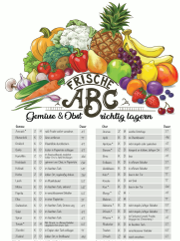Create the right storage conditions
First of all, the onions need to be dried sufficiently after harvesting. Only dry specimens keep in place. If there is still residual moisture in the pods or the remaining shoots, there is a risk of rot. Mold finds a good breeding ground here.
Once the harvest is sufficiently dry, it can be stored in a dry, dark and cool room.
It is important to ensure that there is good ventilation and that no moisture can penetrate. Moisture inevitably leads to rot.
The darkness is just as important. It prevents the onions from developing fast-growing shoots. The onion then gives its power to this shoot, it quickly loses substance. In the end, all that's left is a wrinkled, inedible shell.
also read
- Keeping potatoes with onions - not such a good idea!
- Pour the onions sufficiently
- What to do when onions germinate
The right storage location
Onions are best kept in a basement room. It is cool and dry here and daylight cannot penetrate. If you don't have a cellar, you can store the onions in an appropriate storage room.
However, the refrigerator is not the place. It's cool here, but the onions lose their flavor. The short storage of an onion that has already been cut is possible here.
Bearing error
Onions should never be kept in plastic bags. Here they cannot “breathe”, begin to sweat and lazy.
Aluminum foil is also unsuitable. If cut onions are stored wrapped in aluminum foil, a chemical reaction occurs and the onion takes on a metallic taste.
Always keep your onions in an airy basket or net. Leftover onions can be stored in a food-safe container in the refrigerator for a short time.
Store onions in bullet points
Correct storage of the onions is rewarded with a long storage time. The supply can last until the next harvest.
- Be sure to store the onions in a dark place. Even the smallest incidence of light stimulates germination.
- Dry storage is important. Moisture leads to mold and rot.
- Avoid heat. This also promotes expulsion and mold formation.
- Baskets or nets are good storage containers.
- Storage on a rack is not recommended. The struts of the grate can press into the onion, injuring it and making it prone to decay.
- The dry skins of the onion are not removed before storage. They protect against drying out and the penetration of mold spores.
- Onions and garlic can be stored together without any problems.
Preserve onions
If you do not have sufficient storage space, you can pickle your onions, especially silver onions, and thus preserve them.
Pickled silver onions
The onions are peeled and poured with brine (60 g of salt in 1 liter of water). After the onions are steeped for a day, they are rinsed and layered in a sterilized jar with a screw cap. Bay leaves, mustard seeds or herbs can be added for a better taste. Then boil about a liter of white wine vinegar and pour it hot into the glass. Quickly closed, the cooling vinegar can create a vacuum that securely closes the jar. Made in this way, the onions can be kept for over a year.
Freeze onions
Another alternative to storing onions is freezing. However, this method is not necessarily suitable for large quantities of onions, as preparation takes a bit of work. The onions must be peeled and then cut into rings or cubes. Packed in suitable containers, the deep-frozen onions will keep for about a year.
Frozen onions are ideal for cooking because they can be added to dishes in no time at all.

The garden journal freshness-ABC
How can fruit & vegetables be stored correctly so that they stay fresh as long as possible?
The garden journal freshness ABC as a poster:
- as free PDF file to print out on your own



